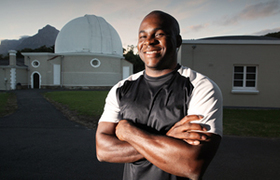Galactic gas distribution may provide clues on dark matter
17 February 20142013 was a "crazy year" for UCT astronomer Dr Bradley Frank. He took 25 flights, married, graduated, became a tax-payer, and is now a postdoctoral fellow at the Netherlands Institute for Radio Astronomy (ASTRON). Here Bradley provides unique insights into his recent PhD research on gas distribution in the galaxies as a clue to elusive dark matter. He spoke to Helen Swingler via email.
HS: What did your PhD research set out to explain?
BF: It focused on the distribution of molecular gas in nearby galaxies. These galaxies formed part of a sample for which we have the some of the best multi-wavelength data available, ie we had observations of different phases of the environment of these galaxies, from the stellar content (the stars), to the neutral hydrogen and the molecular gas. Observations of each of these phases forms a comprehensive picture of the evolution of these galaxies. I worked on calculating the contribution of the molecular gas to the overall mass of the galaxy, using an analysis of the motion of the neutral and molecular gas to deduce the dynamical effect of the dark matter potential in each galaxy, by using different models for the dark matter halo.
HS: What sorts of questions will be answered when the nature of dark matter is identified?
BF: The current picture of our cosmos is that there are three main constituents to our universe: dark energy (about 75%), dark matter (about 20%), and baryonic matter (about 5%). Dark energy is responsible for the evolution of the Universe on very large scales; the physics of dark matter defines how galaxies form and how they evolve. Baryonic matter, ie the stuff that we can see and touch, which stars and planets are made of, comprises a small fraction of the universe. The existence of dark matter poses some serious questions for physics. There is either this exotic form of matter that only interacts gravitationally, or our idea of gravity is incomplete. Either way, the existence of dark matter is a puzzle that challenges our understanding of the Universe. Solving the mystery of the missing 'dark' matter could revolutionise physics.
HS: What are the biggest challenges to determining its nature?
BF: At the moment, the only way we can deduce the nature of dark matter is to look at the effect that it has on the matter around it. Dark matter doesn't interact electromagnetically (as far as we know), so we need the next generation of telescopes to peer more closely at the galaxies around us, and at the most distant blobs of radiation being released from the first structures of the universe. To do this we need to develop more sensitive telescopes, but this isn't as easy as building them bigger and better. Radio frequency interference generated by cell phone towers, GPS satellites and other devices is making it increasingly difficult to detect the faint astronomical radiation from the booming man-made signals. It's like trying to listen to a whisper while a Boeing 747 flies past on the runway. These issues, coupled with the genuine complexity of operating a large radio telescope, make for a tough challenge. Luckily, we have some very smart people working with us to overcome these challenges; and of course, we have an excellent site for radio astronomy in the Karoo.
 This work is licensed under a Creative Commons Attribution-NoDerivatives 4.0 International License.
This work is licensed under a Creative Commons Attribution-NoDerivatives 4.0 International License.
Please view the republishing articles page for more information.










